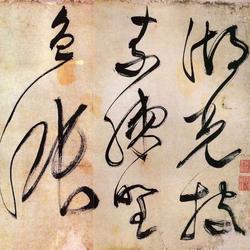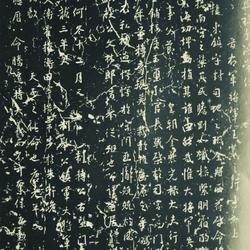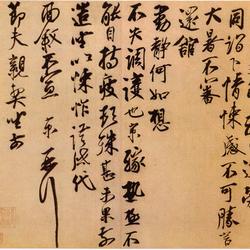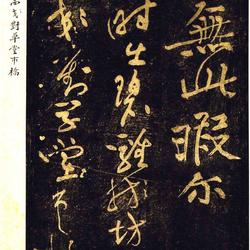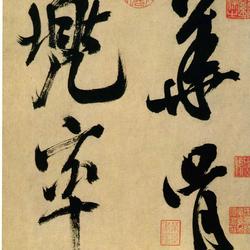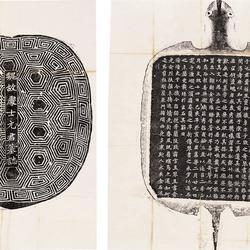Wang Xizhi's "Youmu Tie", also known as "Shudu Tie", is an ink copy, cursive script, paper, 11 lines, 102 words. The possession of Andawan in Hiroshima, Japan, was destroyed by fire.
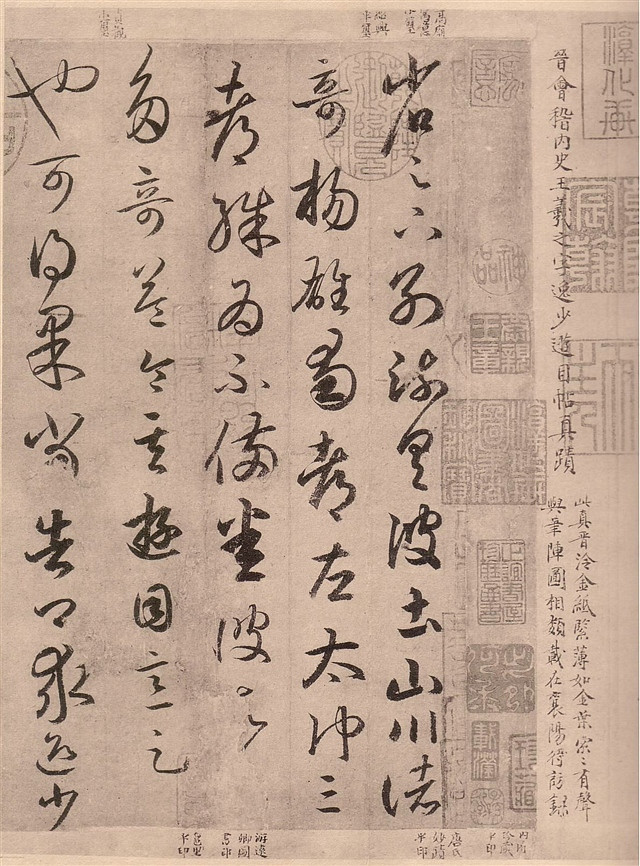
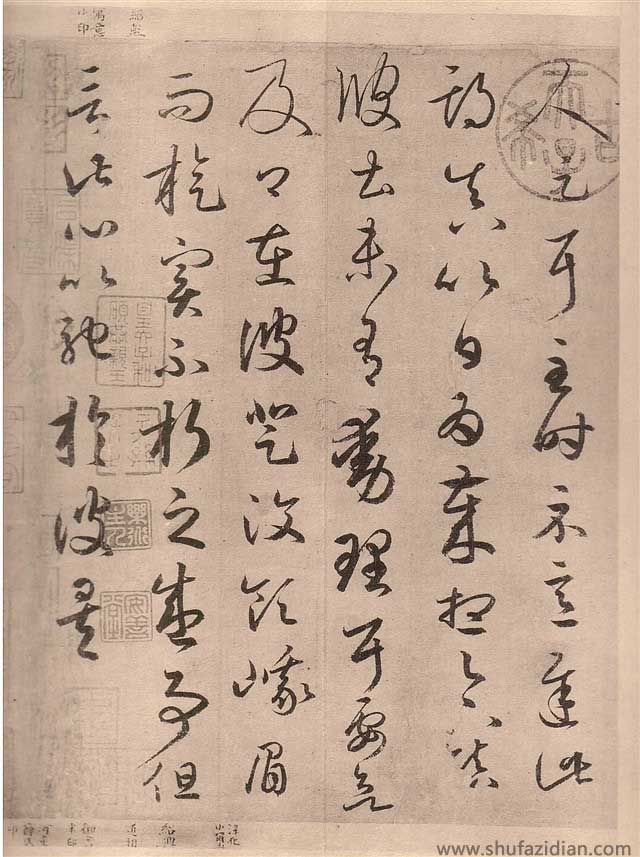
Explanation:
There are many wonders in the mountains and rivers of the province. Yang Xiong's "Sichuan Capital" and Zuo Taichong's "Three Capitals" are all unprepared. Knowing that there are many strange things about him will make his eyes full. If you can get the result, you should inform your ministers and ask for welcome. Few people have enough ears. Signal when the time comes. If it is later than this period, the day will be counted as the year. I want to take a single step to control that land, but I haven't moved my ears. If you want to catch up with you there, you can climb to Wenling and circle around Mount Emei, which will be an immortal event. But saying this, my heart is at ease with him.
This post was among the people in the Song and Ming dynasties. It entered the imperial palace in the twelfth year of Qianlong's reign in the Qing Dynasty (1747). It was given to Prince Gong during the Xianfeng and Tongzhi years. It was later owned by Adachi Manzo, Hiroshima, Japan. Naito Hunan was once the Adachi bookkeeper. Postscript.
This post has been framed many times, and the collection and appreciation seals between the front and back water gaps are blurred, including the imperial seal of Qianlong and the seal of Prince Gong. The inscription outside the water on the front is "Authentic copy of Youmu Tie" written by Wang Xizhi, the internal history of Jin Kuaiji. There is an unnamed postscript on the inscription: "This is genuine Jin Ling gold paper. It is as tight and thin as gold. It has a sound and is consistent with the pen pattern. The category is recorded in Xiangyang for interview." At the end of the post, there is an inscription and postscript of Shouhe's review: "There is a two-character small seal of Zhong Shaojing. Zhong Gai was the Duke of Yue in the Tang Dynasty. There are three posts of Xie Yi, Xie An, and Huan Wen of Jin Dynasty, and Huang Su "Huang Ting Jing" all has this seal. See Mi Yuanzhang's "Baozhang Waiting for Visits". And "Huang Ting Jing" is now stored in Leizhou, Han Dynasty. I have seen it many times, especially as a proof." There is a photocopy of this post by Anda. . The copy was destroyed in a fire, and only the photos survive.
This letter was written by Wang Xizhi to Zhou Fu, the governor of Yizhou. The letter expressed Wang Xizhi's yearning for the wonderful mountains and rivers of Xitu. Zhou Fu, courtesy name Daohe, was the son of Zhou Fang, a famous general in Zhongxing Dynasty in the Eastern Jin Dynasty. He was originally from Ancheng, Runan, and later moved to Xunyang. In the first year of Yongchang (322), he became Wang Dun's minion. In the second year of Taining (324), Wang Dun failed, and Zhou Fu and others fled into the Xiyang barbarians. In the third year of Taining, the imperial court granted amnesty. In the early years of Xianhe (326 years), Zhou Fu was used by Wang Dao. He died in June of the third year of Xingning (365 AD) and was appointed governor of Yizhou. Wang Xizhi had a close relationship with Zhou Fu and had many inquiries.
The calligraphy of this calligraphy is beautiful but not feminine, agile but not frivolous, strong but not forceful, and clever but not reserved. Xiaoru of the Ming Dynasty praised it: ""Youmu Tie" combines strictness with indulgence, and accumulates roundness with strength. Its beginning and end are inflections, just like the divine destiny created by heaven. The changes are sudden and unpredictable, which is surprising and self-defeating."
The Rebirth of Wang Xizhi's "Youmu Tie"
On December 3, 2007, the long-lost calligraphy work "You Mu Tie" by Wang Xizhi was finally re-presented in front of people as scheduled. Spread out on the exhibition stand of the Central Academy of Fine Arts Museum in Beijing, it is as lifelike as the original handwriting written by Wang Xizhi more than 1,600 years ago. People can't help but marvel at the restoration magic of modern high-tech. However, the wandering "life" of "Youmu Tie" is even more lamentable: he was born in the troubled times of the Eastern Jin Dynasty, and throughout the five dynasties of Tang, Song, Yuan, Ming and Qing dynasties, from emperors and generals to common people, they all He took it as a treasure in his pocket, but unexpectedly things were unpredictable. When the Eight-Power Allied Forces invaded in the late Qing Dynasty, he was not spared the fate of exile overseas. He was finally burned in the atomic bombing of Hiroshima, Japan during World War II...
On December 8, the weekend in Beijing, Wangfujing Street was bustling with shopping people.
In Xiaowei Hutong on the east side of the street, a group of "national treasures" ancient Chinese calligraphy and paintings are on display at the art museum.
Zhao Lihua came over from home early in the morning. As he expected, many experts and enthusiasts of calligraphy and painting gathered here on this day, who wanted to see Wang Xizhi's handwriting - "You Mu Tie".
The "Youmu Tie" displayed in front of you, in addition to the text of the post, is written with the four characters "Dezhi Shenggong" at the beginning of the right. This is the postscript inscribed by Qianlong (note: the postscript refers to the text inscribed after the scroll). The postscript is surrounded by Covered with Qianlong's jade seal. In the blank space at the top of the post, there is the word "Zhenguan", which may be the seal of Emperor Taizong Li Shimin of the Tang Dynasty. On the other page, there are two seals of "Emperor Sixth Son" and "Prince Gong" between the two postscripts, which are the seals of Emperor Daoguang's death. The seal of the sixth son of the emperor, Yi , was granted by the previous decree. At the end there is a new postscript written by the Japanese sinologist Tora Naito in 1933. These historical marks clearly show that these famous emperors and generals in history have had an indissoluble bond with this post.
What is even more eye-catching is the legendary "life" of "Youmu Tie": As an important work of Wang Xizhi, "Youmu Tie" has become the object of coveted by the world as soon as it came out. The original copy of the "Youmu Tie" has long been lost, and the only remaining copy is from In the Tang Dynasty, the Qing government received this post in the twelfth year of Qianlong's reign. When the Eight-Power Allied Forces invaded, it flowed out of Prince Gong's Mansion and later flowed into Japan. When the atomic bomb exploded in Hiroshima in 1945, it was stored in a warehouse in Hiroshima City, along with 140,000 lives. Turn into dust together.
However, on this day in 2007, it was reborn in a modern high-tech form. After more than a year of repeated trials by Zhao Lihua, a cultural relic reproduction expert from the Cultural Relics Publishing House, and his four or five young people, "Youmutie" was finally restored to its original appearance. To the surprise of the on-site experts, the depth of the ink marks on the post, the density of the ink pad, and even the stains and old parts were all lifelike. After viewing it, Fu Xinian, a calligraphy and painting connoisseur, said that "You Mu Tie" had "come back to life"!
The final appearance of "Youmu Tie"
Wang Xizhi's "Youmu Tie" is also known as "Shudu Tie". It is a paper copy with 11 lines and 102 words. It is one of Wang Xizhi's letters with a larger number of words. This calligraphy has always been widely praised and is considered to be Wang Xizhi's most outstanding cursive calligraphy work. Some calligraphy enthusiasts commented on this post: "beautiful but not feminine, nimble but not frivolous, strong but not aggressive, clever but not reserved." Fang Xiaoru of the Ming Dynasty even commented: ""You Mu Tie" 》It combines strictness with indulgence, and accumulates round strength with force. Its beginning and end are twists and turns, just like the divine destiny created by heaven. The changes are sudden and unpredictable, and it is surprising and self-defeating.”
What makes many calligraphy and painting collectors sad is that this treasure was destroyed in the artillery fire of World War II.
On the morning of August 6, 1945, Hiroshima, Japan. Three planes flew over Hiroshima.
At 8:15, an atomic bomb named "Little Boy" exploded. The fireball burst out with radiant heat eight times higher than the surface temperature of the sun. Within a radius of 1.6 kilometers from the center of the explosion, the steel frame collapsed and the concrete turned into powder and sand. Sintered into glass, trees turned into charcoal, and human bodies reduced to ashes. Three minutes after the explosion, sticky black radiation rained down from the sky, bringing with it deadly nuclear fallout.
The Manzo Adachi family living in Hiroshima was evacuated by the government in advance and escaped, but they were unable to take away the items stored in the warehouse in time. "Yumote" was among them.
"Youmutie" experienced the most glorious five dynasties of the Chinese Empire: Tang, Song, Yuan, Ming, and Qing. At the end of the Qing Dynasty, its fate was as painful as that of the nation, and it was exiled in a foreign country. Finally, it suffered in World War II marked by the atomic bomb explosion. The last figure left in the final chapter.
This work, once stored in the pavilions and palaces of the capital, was guarded, admired, copied and coveted by countless people. Like many cultural relics preserved by the Qing Dynasty, it flowed from the capital to Tianjin, Shanghai, Guangzhou, and then to Japan through these ports. , the United States and Europe, their owners have also changed from Chinese officials with long braids and long gowns to European-style upper-class figures in suits and leather shoes. During the Boxer Rebellion, it left Beijing's Prince Gong's Mansion and was acquired by Japanese businessmen. After flowing into Japan, it was purchased by the Adachi Manzo family in Hiroshima.
On April 9, 1913, people in the literary and artistic circles in Kyoto, Japan held the "Orchid Pavilion Poetry Meeting" to commemorate the Orchid Pavilion event in Shanyin, Kuaiji, in commemoration of Guichou, the ninth year of Yonghe in the Eastern Jin Dynasty (AD 353). Attendees took out their collections of treasures for public display. Adachi Manzo also brought his "Yumoku Post" to the meeting. When the post was spread out on the table, the whole audience was shocked. Scholars Wang Guowei and Luo Zhenyu from China were also invited to the scene.
However, this was the last documented public appearance of "Youmu Tie".
Some information confirms that "Youmu Tie" has been collected by Anda Manzo since then. In 1933, he brought the original to the famous Japanese sinologist Tora Naito to request an inscription and postscript. In 1934, he printed a copy of the "Color Edition". However, this is all that future generations can know about "Youmu Tie" and its last owner. At the beginning of this year, Nigensha Japan searched for the descendants of Adachi Manzo in the Hiroshima newspaper "China News" and finally found the grandson's daughter-in-law of the Adachi family. The old lady was over 80 years old and not very conscious. She confirmed that all Anda's collection had indeed disappeared in that human tragedy.
At this point, it has been concluded that "Youmu Tie" was destroyed by the atomic bomb, and there are only three black and white copies of the Colo version of "Youmu Tie" left in the world (Note: Colo printing is a kind of photosensitive technology, and its biggest advantage is that there is no Generally, lithographic offset printing products cannot avoid dot marks, so they are closer to the original works, especially when expressing Chinese ink paintings and calligraphy, which are more subtle and realistic).
Even if the original post has been destroyed, its value is the same as the original.
"Youmu Tie" Past Life
"You Mu Tie" is originally a letter, one of the letters that Wang Xi exchanged with Zhou Fu, the governor of Yizhou, during his middle age. The entire post has 102 words:
There are no sparse places under the province, and there are all the wonders of the land, mountains and rivers. Yang Xiong's "Sichuan Capital" and Zuo Taichong's "Three Capitals" are extremely unfamiliar. Therefore, there are many strange things, which makes his eyes full and satisfied. If you can get the result, you should tell your ministers to ask for welcome, and few people will be able to hear it. When the time comes, it means that after this period, the day will really count as the year. I want to take a single step to control that land, but I haven't moved my ears. If you want to meet your ministers there, you can climb up to Mount Emei and circle around, which will be an immortal event. But saying this, my heart is at ease with him.
Translated into vernacular, the general meaning is: "The various wonderful places of Bashu mountains and rivers mentioned in your letter are not described in Yang Xiong's "Ode to the Capital of Shu" and Zuo Si's "Ode to the Three Capitals". The strange mountains and rivers of your land make people feel even more Only when you visit and see can you be satisfied. If you can make the trip, please welcome your Excellency. If you delay this opportunity, your days will really feel like years. Guarding Bashu with one step, the court will not have any reason to transfer. I really want to board the trip with you when you are in Bashu. If we return to Wenling and Mount Emei, that will be an immortal event."
This ordinary letter, due to the master's exquisite calligraphy, became a treasure as soon as it was completed. In the years to come, it became a coveted item for any emperor who held power in the Chinese Empire.
In the early years of Zhenguan in the Tang Dynasty, Emperor Taizong Li Shimin issued an edict and ordered people to take out the gold and silk from the inner palace to conduct an extensive search among the people for the authentic writings of the king. Eventually, more than 3,000 pieces were found, including "Youmu Tie".
In the third year of Chunhua in the Northern Song Dynasty, Taizong Zhao Guangyi ordered an ancient calligraphy series to be engraved, and "Youmu Tie" was also included in it.
During the Hongwu period of the early Ming Dynasty, "Youmu Tie" was acquired by a man named Zheng Ji, who invited Fang Xiaoru to write a postscript for it. Fang Xiaoru said that this post "combines strictness with indulgence, and accumulates round energy with beating. Its starting and ending twists and turns are like divine destiny created by heaven. The changes are sudden and unpredictable, and it is surprising and self-defeating."
At the end of the Ming Dynasty, "Youmu Tie" was circulated to collector Xu Shouhe. At this time, "Youmu Tie" had been torn apart several times, covered in dust, and severely damaged. When Xu Shouhe received this scroll, "it was so full of seals that it was difficult to distinguish it with squinted eyes." He washed away the dirt and remounted it. Xu Shouhe wrote in the postscript that this post was written on cold gold paper of the Jin Dynasty. After washing away the scum, you can see that "the Zhenguan's seal's red halo is calm, deep into the skin of the paper, and it is not disappearing." The other seals of the Tang and Song Dynasties are also Identify one by one.
In the twelfth year of Qianlong's reign in the Qing Dynasty, Emperor Qianlong recovered this calligraphy from the people and engraved it into the "Sanxitang Dharma Calligraphy". Qianlong was most fond of the "Kuai Xue Shi Qing Tie". After acquiring this post, he said that it was "hardly comparable" to the "Kuai Snow Shi Qing Tie" and he wrote many postscripts and seals. During the years of Xianfeng and Tongzhi, Prince Gong was given the title Yi, and later it was passed to Yi's second son Zaiying.
At this point, "Youmu Tie" ended its more than 1,300 years of wandering, stayed in Prince Gong's Mansion, returned to the temple, was heavily cared for, and shared the last century and a half of peace with the empire.
It escaped from Prince Gong's Mansion during the Boxer Rebellion. It went to Japan after the Revolution of 1911 and was collected by Adachi Manzo in Hiroshima Prefecture. It was destroyed by the atomic bombing in 1945. Only the 1925 copy remains.
Looking for posts
Half a century later, many people still remember "Youmu Tie". After liberation, Pu Xinshe, the grandson of Prince Gong Yi, recalled the collection in Prince Gong's palace and was still brooding over the destruction of "Youmu Tie".
In 1997, Zhao Lihua, who worked at the Cultural Relics Publishing House, saw Wang Xizhi's "Youmu Post" in a picture album. He was deeply moved by the legendary experience of this post.
Later, he visited an exhibition in Tokyo. There were 12 screens from the Edo period in Japan. Two of them were destroyed in World War II. Only black-and-white photos of the screens have been handed down. The Japanese calligraphy and painting community has conducted research on the colors of the remaining 10 screens. After analysis, technical means were used to restore the other two screens. After reading it, Zhao Lihua was deeply inspired and decided to try to restore "You Mu Tie".
After several years of trying, in early 2006, Zhao Lihua, who was the director of the Cultural Relics Restoration and Copying Center, asked Nigensha in Japan (Note: Nigensha is a publishing house in Japan that has been copying ancient Chinese calligraphy and paintings since the 1970s and has copied 400 cultural relics for the National Palace Museum in Taipei). He expressed his desire to restore "Youmu Tie" and hoped that the other party would help find the Colo version of "Youmu Tie".
Zhao Lihua's idea hit it off with Erxuan Society.
After a year of searching and asking friends in the Japanese painting and calligraphy collection community, in March 2007, Fugensha discovered the collotype plate that was commissioned by the Adachi Manzo clan to make photo plates from Kobayashi in Kyoto in 1934. What surprised Zhao Lihua was that this Colo version was not only the same size as the original, but also included all the inscriptions and postscripts.
rebirth
However, the difficulty of restoring "Youmu Tie" is greater than any previous copy. What Zhao Lihua and his working group of four or five young people need to do is to restore a black-and-white copy of "Youmu Tie" to color . Except for the strokes, the ink density must be exactly the same as the original note.
Just the huge research project can put many people away.
The materials for ancient Chinese calligraphy and painting have changed greatly over the ages. Zhao Lihua gave an example: "The silk in the Song Dynasty was very densely woven, with one warp and one weft. In later dynasties, there were sometimes one warp and two weft, or two warp and two weft." Roots, different weaving methods, the inking effect will be different."
Rice paper is also different. Nowadays, standard rice paper actually uses sandalwood bark and straw as the main raw materials. In the past, mulberry bark and hemp bark were used to make rice paper. The paper of the Tang Dynasty was thin but strong, the paper of the Ming Dynasty was as soft as silk, but the paper of today is different, making a squeaking sound when shaken.
The light resistance and water resistance of paper and ink are also the focus of the test. In long-term exhibitions, light can greatly stimulate calligraphy and painting, which can easily lead to discoloration.
In order to find the right paper, Zhao Lihua and his team conducted experiments from the very beginning. They covered half of the finished paper and stuck it on glass to dry in the sun for two years. Finally, they chose a color with no changes on both sides. paper. Traditional Chinese calligraphy and painting need to be framed, and water needs to be sprayed on the calligraphy and painting, which is very harmful to the work. In order to find the right ink, they boiled it with boiling water and even rubbed it with soap during the test.
The restored "Youmu Tie" is based on the paper used for the introduction to "Han Shanzi's Poem on a Layman" by Huang Tingjian of the Song Dynasty collected by the National Palace Museum in Taipei as the basis for the paper color of the introduction part written by Qianlong; it is based on the "Yuanhuan Tie" from the National Palace Museum in Taipei. The basis for determining the paper color of part of the frame; the rest of the paper and Ayako were restored with reference to contemporary materials.
In addition to the material, how to color is also a difficult problem.
The only remaining "Youmu Tie" is in black and white, and it is impossible to obtain the color information of the original from the existing materials in the world. Moreover, it has been more than 100 years since the original "Youmu Tie" left China and more than 60 years since it was destroyed. No one in the world has ever read the original in person.
Are the dark areas on the paper ink marks or stains? Many can only be analyzed by experts, tried based on experience, and finally compared with the Colo version.
In terms of seals, the color of the same seal of the same figure in the existing works shall prevail. Other unexamined seals shall be processed in the same way as the seals on other ancient calligraphy and paintings according to the shades of the Colo version and the characteristics of the times. The ink colors of the inscriptions and postscripts of Qianlong and others were processed with reference to those handed down from ancient times.
After all these preliminary preparations are completed, the restoration of "Youmu Tie" enters the actual operation stage.
The staff first used a specially customized machine to scan the collotype version of "Youmu Tie" into the computer. Nowadays, it only takes tens of seconds to use new digital technology to scan images. However, in the 1970s, when Japan's Fugensha Co. , Ltd. was copying calligraphy and paintings for the National Palace Museum in Taipei, in order to image the calligraphy and paintings, a specially built machine with a length of 5 meters, a width of 2 meters and a height of 2 meters was specially built . The flash speed of a 3-ton camera is reduced to one ten thousandth, and it takes several hours to take a picture.
After inputting the data, Zhao Lihua and others colored different parts of the post based on the information from the previous research. The four colors used in the ordinary printing process are no longer enough, and 12-color printing is finally used. In addition to color separation being very cumbersome, moisture control is also very critical. When water is sprayed onto the paper, it will spread out. If there is too much water, the picture will be distorted. If it is too little, the expression will be insufficient .
The final color correction step is also the most test of the producer's experience and artistic skills. Compared with the original work, whether the color needs to be increased or decreased, whether there is any difference in brightness, whether the ink is standard, requires technical personnel to compare every detail.
After more than a dozen color corrections, which took several months, "Youmutie" was successfully restored on July 10, 2007.

